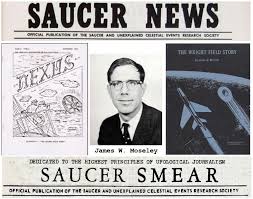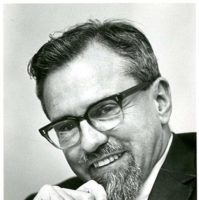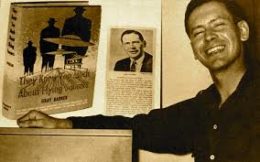By Charles Lear
 In the early days of the modern UFO era, if you were an American and you saw something strange in the sky and wanted someone to investigate, you reported it to the Air Force. If the Air Force dismissed your case as unworthy of study before 1952, there were no other organizations to turn to. There were a few private individuals who might be willing to look into it, but they were usually under contract with publications such as True Magazine, Look Magazine, and Fate, which meant that there would be some publicity involved. There was a need for a private organization of dedicated researchers and, by the end of 1952, three groups had formed to fill it. The first two were the International Flying Saucer Bureau founded by Albert K. Bender, based in Connecticut and Civilian Saucer Investigation, a Los Angeles based group. IFSB had Gray Barker, an imaginative writer, as its chief investigator while CSI was founded by North American Aviation engineer, Edward J. Sullivan and had, as one of its investigators, Walther Riedel, one of the V-2 creators who had come to America as part of operation paperclip. The third group was The Aerial Phenomena Research Organization started in January, 1952 by Jim And Coral Lorenzen. Both IFSB and CSI had ceased operations by 1954, while APRO continued until 1988. In 1954, an organization was formed in New York City called, Civilian Saucer Intelligence New York by Alexander Mebane, Isabel Davis, and Ted Bloecher, who held CSI-LA in high regard. CSI-NY is notable, not only for the caliber of their primary researchers but also, for their association with the biggest names in early saucer and paranormal research. They would also have a huge impact on UFOlogy with their assistance to a young J. Allen Hynek. Hynek, as a consultant for the Air Force’s Project Blue Book was, discretely, seeking outside help in the midst of what he felt was a less than earnest attempt by the Air Force to get to the root of the mystery. The group lasted for five years and shortened the name to Civilian Saucer Research in July of 1957. They did a lot of hard work researching and cataloguing sightings reports, held monthly meetings and published newsletters for their membership. Many of the publications were archived by the Center for UFO Studies and are available today on the CUFOS website. Reading through them, one is taken back to a time in UFOlogy when “flying saucer” was still the major term being used and some of its most colorful characters were just coming to public attention.
In the early days of the modern UFO era, if you were an American and you saw something strange in the sky and wanted someone to investigate, you reported it to the Air Force. If the Air Force dismissed your case as unworthy of study before 1952, there were no other organizations to turn to. There were a few private individuals who might be willing to look into it, but they were usually under contract with publications such as True Magazine, Look Magazine, and Fate, which meant that there would be some publicity involved. There was a need for a private organization of dedicated researchers and, by the end of 1952, three groups had formed to fill it. The first two were the International Flying Saucer Bureau founded by Albert K. Bender, based in Connecticut and Civilian Saucer Investigation, a Los Angeles based group. IFSB had Gray Barker, an imaginative writer, as its chief investigator while CSI was founded by North American Aviation engineer, Edward J. Sullivan and had, as one of its investigators, Walther Riedel, one of the V-2 creators who had come to America as part of operation paperclip. The third group was The Aerial Phenomena Research Organization started in January, 1952 by Jim And Coral Lorenzen. Both IFSB and CSI had ceased operations by 1954, while APRO continued until 1988. In 1954, an organization was formed in New York City called, Civilian Saucer Intelligence New York by Alexander Mebane, Isabel Davis, and Ted Bloecher, who held CSI-LA in high regard. CSI-NY is notable, not only for the caliber of their primary researchers but also, for their association with the biggest names in early saucer and paranormal research. They would also have a huge impact on UFOlogy with their assistance to a young J. Allen Hynek. Hynek, as a consultant for the Air Force’s Project Blue Book was, discretely, seeking outside help in the midst of what he felt was a less than earnest attempt by the Air Force to get to the root of the mystery. The group lasted for five years and shortened the name to Civilian Saucer Research in July of 1957. They did a lot of hard work researching and cataloguing sightings reports, held monthly meetings and published newsletters for their membership. Many of the publications were archived by the Center for UFO Studies and are available today on the CUFOS website. Reading through them, one is taken back to a time in UFOlogy when “flying saucer” was still the major term being used and some of its most colorful characters were just coming to public attention.
 CSI-NY’s “Statement of Policy” is a five-point outline of the group’s agreed upon approach. They believed flying saucers were real objects, possibly of extraterrestrial origin, and that the most “useful activity” would be to collect and study all related material and attempt to offer explanations that were “based on natural rather than supernatural premises. Point five deals with contactees and it was felt that the evidence supporting their claims was “incomplete and not sufficiently cohesive to justify study by the organization as a whole.” The contactee movement was in its infancy and one of the earliest speakers hosted by CSI-NY was George Adamski, who was paid a fee of $100. It seems they were not impressed and they would later offer scathing criticisms of the contactees and expose the hoaxers and con-men among them in their December 15, 1956 newsletter devoted to “The Need For Outspoken Criticism.” The editors make the point that “the exposure and discrediting of the saucer frauds must come from saucer researchers themselves” in order for the public to make a “distinction between the two.” George Van Tassel is mentioned as trying to raise $60,000 to build a machine that could restore youth by bringing the electrons in our bodies back to a circular orbit, which he claimed became more eccentric with age. Van Tassel did actually build what he called an “Integratron” but that’s another story.
CSI-NY’s “Statement of Policy” is a five-point outline of the group’s agreed upon approach. They believed flying saucers were real objects, possibly of extraterrestrial origin, and that the most “useful activity” would be to collect and study all related material and attempt to offer explanations that were “based on natural rather than supernatural premises. Point five deals with contactees and it was felt that the evidence supporting their claims was “incomplete and not sufficiently cohesive to justify study by the organization as a whole.” The contactee movement was in its infancy and one of the earliest speakers hosted by CSI-NY was George Adamski, who was paid a fee of $100. It seems they were not impressed and they would later offer scathing criticisms of the contactees and expose the hoaxers and con-men among them in their December 15, 1956 newsletter devoted to “The Need For Outspoken Criticism.” The editors make the point that “the exposure and discrediting of the saucer frauds must come from saucer researchers themselves” in order for the public to make a “distinction between the two.” George Van Tassel is mentioned as trying to raise $60,000 to build a machine that could restore youth by bringing the electrons in our bodies back to a circular orbit, which he claimed became more eccentric with age. Van Tassel did actually build what he called an “Integratron” but that’s another story.
 “CSI Publication #0” is a “resume” of their April 23, 1954 meeting. The speaker was Dr. Ivan T. Sanderson who was an esteemed British naturalist, Fortean researcher and inventor of the term, “cryptozoology.” Sanderson was the primary researcher for the September 12, 1952 Flatwoods Monster case and that was the subject of his talk. Sanderson would become more and more involved with CSI, first as a “valued friend” and then as an elected officer to serve as Third Vice-President (Public Relations) on November 7, 1956. Sanderson was friends with Gray Barker, who would also speak at CSI, and James Moseley, who was President of CSI from 1954-1956. For such a serious group of researchers, Moseley was not destined to remain long as their president and spent a good deal of his term away on trips to South America. Moseley and Barker would later write a series of prank letters on stolen State Department stationary including one to George Adamski from an “R.E. Straith” praising his work, one to the Lorenzens telling them to cease publications before they were cracked down upon by what was inferred to by the U.S. Post Office and a letter to Bloecher intended for Mebane discussing allocation of National Science Foundation funds. The letter to Adamski is mentioned as being a hoax in “CSI Publication #23” but the source of all letters remained a secret until Moseley confessed to them after Gray Barker died in 1984.
“CSI Publication #0” is a “resume” of their April 23, 1954 meeting. The speaker was Dr. Ivan T. Sanderson who was an esteemed British naturalist, Fortean researcher and inventor of the term, “cryptozoology.” Sanderson was the primary researcher for the September 12, 1952 Flatwoods Monster case and that was the subject of his talk. Sanderson would become more and more involved with CSI, first as a “valued friend” and then as an elected officer to serve as Third Vice-President (Public Relations) on November 7, 1956. Sanderson was friends with Gray Barker, who would also speak at CSI, and James Moseley, who was President of CSI from 1954-1956. For such a serious group of researchers, Moseley was not destined to remain long as their president and spent a good deal of his term away on trips to South America. Moseley and Barker would later write a series of prank letters on stolen State Department stationary including one to George Adamski from an “R.E. Straith” praising his work, one to the Lorenzens telling them to cease publications before they were cracked down upon by what was inferred to by the U.S. Post Office and a letter to Bloecher intended for Mebane discussing allocation of National Science Foundation funds. The letter to Adamski is mentioned as being a hoax in “CSI Publication #23” but the source of all letters remained a secret until Moseley confessed to them after Gray Barker died in 1984.
 The line up of speakers hosted by CSI is a who’s who of early 50’s flying saucer research. There was Frank Edwards, who was the first radio broadcaster to seriously examine flying saucer reports on air, Morris K. Jessup, author of the 1955 classic, “The Case For UFOs”, Donald Keyhoe, before he helmed the National Investigations Committee on Aerial Phenomena and Gray Barker, speaking about “reported intimidation of UFO researchers” before he published, “They Knew Too Much About Flying Saucers.” Reading through the CSI publications that reviewed the talks and included transcriptions takes one back to an exciting time when much of UFO history was being made. What’s special is that one can view it from the perspective of an insider.
The line up of speakers hosted by CSI is a who’s who of early 50’s flying saucer research. There was Frank Edwards, who was the first radio broadcaster to seriously examine flying saucer reports on air, Morris K. Jessup, author of the 1955 classic, “The Case For UFOs”, Donald Keyhoe, before he helmed the National Investigations Committee on Aerial Phenomena and Gray Barker, speaking about “reported intimidation of UFO researchers” before he published, “They Knew Too Much About Flying Saucers.” Reading through the CSI publications that reviewed the talks and included transcriptions takes one back to an exciting time when much of UFO history was being made. What’s special is that one can view it from the perspective of an insider.
A lot of N.I.C.A.P. history happened between November of 1956 and January of 1957 and it’s reported in CSI’s newsletters with a striking prescience. In CSI “Issue No. 6” December 15, 1957, the November 3rd election of N.I.C.A.P.’s Board of Governors is announced and the editors wish them success. They do, however, express concern about N.I.C.A.P.’s organizer and “spark plug” T. Townsend Brown. Brown claimed to have constructed an electromagnetic device that could produce an anti-gravity effect. Researchers in anti-gravity and physics were consulted by CSI and expressed strong doubt that any such breakthrough had been made. There was also the mention that there was a provision that allowed board members to buy voting strength and that this could lead to problems. In “CSI Publication 19” May 1, 1957, the news of “the rebirth of N.I.C.A.P.” is announced. Brown and his associates were trying to get other members to pay them salaries of “$15,000 and more” and using the aforementioned provision as a means to do so. This caused an upheaval, Brown resigned on January 18th and Donald Keyhoe was appointed the new director.
Besides the history represented in this archive, one can see the evidence of the hard work of CSI’s officers and researchers. There are long transcriptions of taped speeches, long lists of recent sightings with extensive detail and, after a description of a speech given by Ted Bloecher, “Saucer Landings And Little Men”, there is a list of 56 references! Isabel Davis did some wonderful research on the Kelly-Hopkinsville Incident and she and Bloecher wrote a thorough report that stands as the primary source of information on the subject. Davis also translated the work of French UFO researcher, Aimé Michel into English beginning with her work for the 1956 publication by Criterion Books under the title, “The Truth About Flying Saucers.” The group collected reports and set up a cross-indexed card catalogue that they announced to their members in 1957 was expected to reach 4000 reports and set up a library with books and articles available for use by researchers. Their financial statements reflect that they operated on very little money with a report covering October 1, 1955 to June 3, 1956 stating an income of $1981.90 and expenditures of $1939.80.
There is a huge amount of information contained in the archive and it’s organized linearly which makes for easier research. There are many more stories to be gleaned than can be covered here. There are famous names and famous events but the people whose hard work preserved a special perspective on the 50’s saucer scene are not. Mebane, Davis, Bloecher and other CSI officers and members were among the pioneers of civilian flying saucer research and that they managed not to get sucked into the whirlpool of craziness and zealotry that haunts the subject is reflected in the evolution of their Statement of Policy:
January 4, 1957
There are as yet unidentified objects or manifestations in our atmosphere.
They are of diverse forms, suggesting various origins.
Some of them appear to be material objects.
Some seem to be controlled by intelligences.
Some appear to be constructions.
Some of them appear to have landed.
CSI has no reason at this time to believe that;
UFOs have any occult or religious connotation.
Anyone on this earth has had any communication with UFOs or their occupants.
CSI undertakes to: Collect reports.
Investigate at first hand, when possible.
Evaluate evidence by established scientific principles. Disseminate its findings.